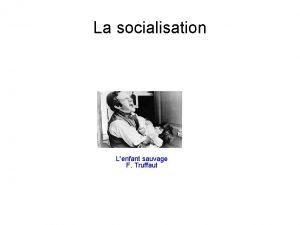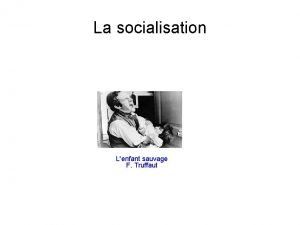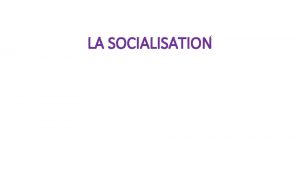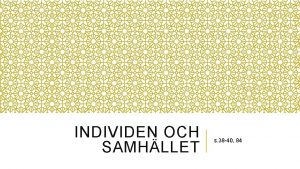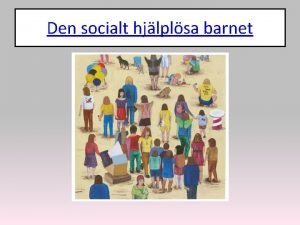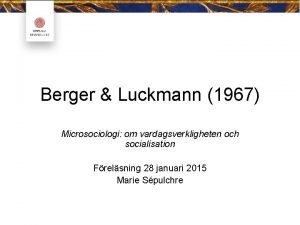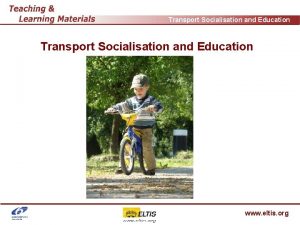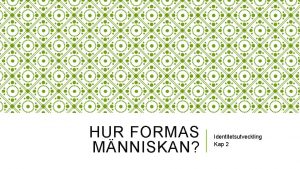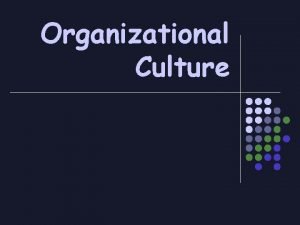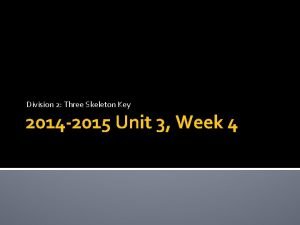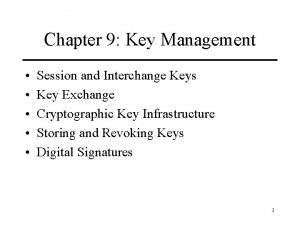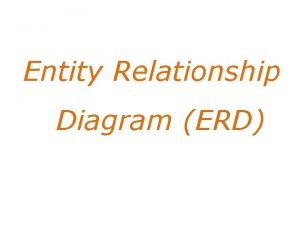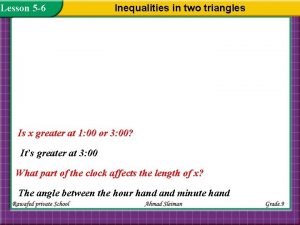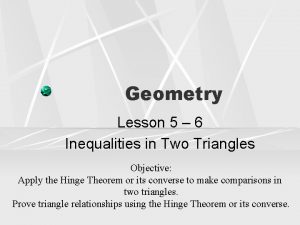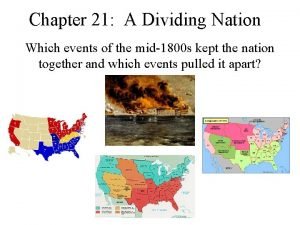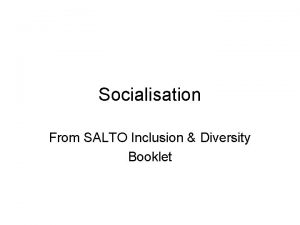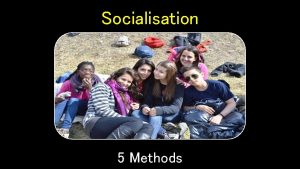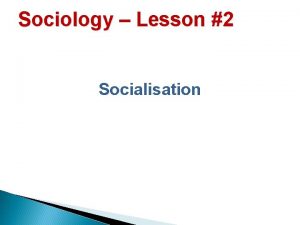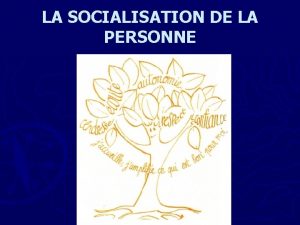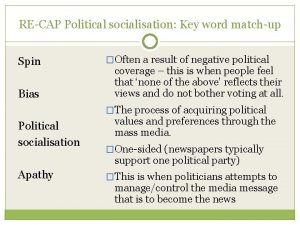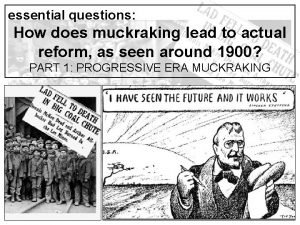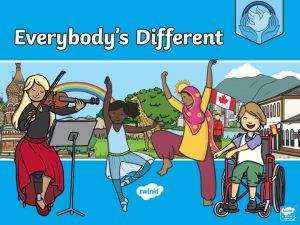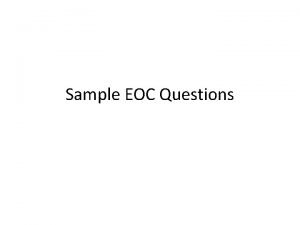Socialisation TWO KEY QUESTIONS How does socialisation lead



























- Slides: 27

Socialisation TWO KEY QUESTIONS… How does socialisation lead to: 1) the development of identity? 2) social control?

Exam question Explain the role socialisation plays in determining how an individual’s sense of identity is presented. Using the stimulus material and information from the course, evaluate alternative viewpoints in relation to the development of self.

Roles “…Our sense of self seems to derive primarily from the social roles we play. ” Identity

Psychological behaviourism Positive/negative reinforcements

Interactionism (symbolic interactionism) We only know the self (our identity/who we are) through social interactions/through communicating with others. “But I don’t care what others think…”

Erving Goffman (Interactionist) The Presentation of Self in Everyday Life (1959) We are social actors. Read the section ‘Erving Goffman and the sociology of everyday life’ on pg. 42 -44 of your textbook. Write down any KEY concepts and provide brief definition. I th nter a an t hu actio Th out man nist r c ca oug om beh theo n s h r e o av ri s fro tart elati f soc iour ts b m to on ial is elie an im shi in lea ve ot agi ps ter rn he ne in ac t a r’s d s t vie them ividu ion. wp se al oin lve s t. s

Key concepts Dramaturgy Impression management ‘front-stage’ and ‘back-stage’ Actors/audience Situational properties Civil inattention

When writing about theorists/theories… ONLY use the last name… Goffman’s theory…. As Goffman explains…



Celebrities – Instagram

Situational properties We adapt who we are depending on who we are interacting with… 1) Think of three situations, you regularly experience, which have different ‘properties’ that you must adapt to. Explain how adapt your behaviour accordingly. Example… Job interview At friend’s house, watching TV series (difference between friends too!) With your grandparent

Juggling masks… For example: when we encounter friends from very different social groups.

When in public… Communication strategies change when interacting with strangers Goffman class this “dimming the lights” Inattention, especially in dense places, makes social life possible

No true self (behind the roles) He challenged the idea that each of us, more or less, has a fixed character.

George Herbert Mead The Self Mead focused on the importance of gestures and language for human interaction. Society We think of ourselves as individuals, but we are only able to do so because we are part of a larger social community (i. e. society)

Mead The communication process involves TWO phases: 1. “Conversation of gestures” 2. “Conversation of significant gestures” Mead explains that The self is a reflective process.

Mead Three stages: Language, play and the game. Social interactions that take place via shared symbols such as words, definitions, roles, gestures, rituals etc. Stage one: language (responds to her own gestures in terms of the symbolised attitudes of others)

Mead Stage two: Play - role-playing - in play, the child takes the role of another and acts as though she were the other (e. g. mother, doctor, builder and various other symbolised roles) -This form of role-playing involves a single role at a time. Thus, the other which comes into the child’s experience in play is a “specific other”

Mead Stage 3 – The game - Also involves role-play (but more complex form) - The individual is required to internalise, not merely the character of a single and specific other, but the roles of ALL others who are involved with him in the game. - He must also comprehend the rules of the game, which condition the various roles. This shared understanding/unity of understanding between all the game players is the “generalised other”

George Herbert Mead Significant others – individuals close enough to us to have a strong capacity to motivate Reference groups – consist of others whose social positions and preferences make them especially relevant to our sense of worth Often share commanlities of age, tastes, status, and interests Generalised other - Any time that an actor tries to imagine what is expected of them, they are taking on the perspective of the generalized other

Textbook questions 1) Read ‘Cooley and Mead: The development of self’ on pg 103 -104 2) Answer the following questions: -What is meant by Mead’s ‘I’ vs ‘Me’? -What is the ‘generalised other’? -How does it relate to identity formation AND social control?

The self and social control The self is of great value to organised society: the internalisation of the conversation of significant symbols allows for the “superior coordination” of “society as a whole” and for the “increased efficiency of the individual as a member of the group” (Mead, 1934)

Charles Cooley “Looking glass” self We know ourselves through the “looking glass” of others that mirrors back to us impressions we create.


“Looking glass” self I am not I think I am not what others think I am what I think others think I am

Seeking approval…(Cooley) Looking for approval is a motivational, fundamental human instinct. Positive approval contributes to our sense of self and social belonging. Spitz orphanage study Haney prison study Other examples…
 Agencies of secondary socialisation
Agencies of secondary socialisation Frequency dependence of dielectric constant
Frequency dependence of dielectric constant Which key resources are we acquiring from partners
Which key resources are we acquiring from partners Contoh bisnis model canvas makanan pdf
Contoh bisnis model canvas makanan pdf Grasshopper dichotomous key
Grasshopper dichotomous key How does ultranationalism lead to crimes against humanity
How does ultranationalism lead to crimes against humanity Instance de socialisation
Instance de socialisation Enfant sauvage socialisation
Enfant sauvage socialisation Objectif socialisation
Objectif socialisation Vad är dubbel socialisation
Vad är dubbel socialisation Vad betyder socialisation
Vad betyder socialisation Types of socialisation
Types of socialisation Berger luckmann socialisation
Berger luckmann socialisation Socialization is a lifelong process through which
Socialization is a lifelong process through which Socialisation
Socialisation Framre
Framre Socialisation du chien
Socialisation du chien Organizational rites
Organizational rites Concept map minerals
Concept map minerals Dichotomous key
Dichotomous key Lesson 1 waves answer key
Lesson 1 waves answer key Three skeleton key theme
Three skeleton key theme Interchage keys
Interchage keys Erd adalah
Erd adalah 5-6 skills practice inequalities involving two triangles
5-6 skills practice inequalities involving two triangles Lesson 5-6 inequalities in two triangles answer key
Lesson 5-6 inequalities in two triangles answer key Chapter 17 section 1 cold war two superpowers face off
Chapter 17 section 1 cold war two superpowers face off Two key details of the fugitive slave act
Two key details of the fugitive slave act






